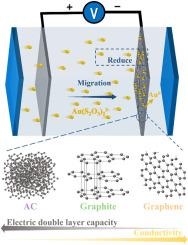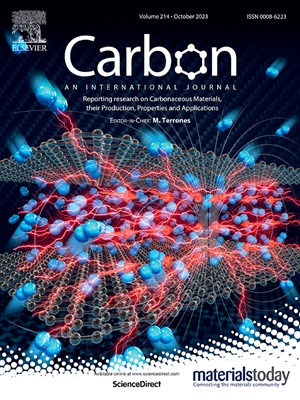Electrochemical reduction and recovery of trace gold(I) from environmentally friendly thiosulfate leaching solutions using carbon electrodes
IF 10.5
2区 材料科学
Q1 CHEMISTRY, PHYSICAL
引用次数: 0
Abstract
Efficient recovery of Au(S2O3)23− at low concentrations is a key challenge for the development of environmentally friendly, cyanide-free thiosulfate leaching methods in industry. In the study, carbon materials including activated carbon (AC), graphite, and graphene were used as electrodes for electrochemical reduction and recovery (electro reduction-recovery) of trace gold(I) from thiosulfate leaching solutions (Au(S2O3)23−). The results demonstrated that Au(S2O3)23− could be efficiently recovered in the form of Au0 with nearly 100 % recovery from both simulated and actual gold ore leaching solutions, significantly simplifying traditional recovery and reduction processes. Even in the presence of impurities such as cations and S2O32−, recovery remained high, around 90 %. Among the parameters studied, applied voltage was the most critical for optimizing recovery, as it enhanced ion migration and significantly improved gold reduction. The study investigated the relationship between the intrinsic properties of carbon materials and their electrochemical reduction and recovery capabilities. Rich porosity of carbon materials promoted interactions with Au(S2O3)23−, enhancing the electric double layer capacity, while π–π∗ satellite transitions played a dominant role in the charge transfer, thereby improving the reduction rate. This research offers new insights of the mechanisms behind the recovery of trace Au(S2O3)23− from thiosulfate leaching solutions through carbon electrodes.

利用碳电极从环境友好型硫代硫酸盐浸出液中电化学还原和回收痕量金(I)
在低浓度下高效回收 Au(S2O3)23- 是工业中开发环境友好型无氰硫酸盐浸出方法的关键挑战。在这项研究中,包括活性炭(AC)、石墨和石墨烯在内的碳材料被用作电极,用于从硫代硫酸盐浸出液(Au(S2O3)23-)中电化学还原和回收(电还原-回收)痕量金(I)。结果表明,Au(S2O3)23- 可以以 Au0 的形式从模拟和实际金矿石浸出液中高效回收,回收率接近 100%,大大简化了传统的回收和还原过程。即使存在阳离子和 S2O32- 等杂质,回收率仍然很高,约为 90%。在所研究的参数中,外加电压对优化回收率最为关键,因为它能增强离子迁移并显著提高金的还原度。研究调查了碳材料的内在特性与其电化学还原和回收能力之间的关系。碳材料丰富的孔隙率促进了与 Au(S2O3)23- 的相互作用,增强了电双层能力,而 π-π∗ 卫星转变在电荷转移中起主导作用,从而提高了还原率。这项研究为通过碳电极从硫代硫酸盐浸出液中回收痕量 Au(S2O3)23- 的机制提供了新的见解。
本文章由计算机程序翻译,如有差异,请以英文原文为准。
求助全文
约1分钟内获得全文
求助全文
来源期刊

Carbon
工程技术-材料科学:综合
CiteScore
20.80
自引率
7.30%
发文量
0
审稿时长
23 days
期刊介绍:
The journal Carbon is an international multidisciplinary forum for communicating scientific advances in the field of carbon materials. It reports new findings related to the formation, structure, properties, behaviors, and technological applications of carbons. Carbons are a broad class of ordered or disordered solid phases composed primarily of elemental carbon, including but not limited to carbon black, carbon fibers and filaments, carbon nanotubes, diamond and diamond-like carbon, fullerenes, glassy carbon, graphite, graphene, graphene-oxide, porous carbons, pyrolytic carbon, and other sp2 and non-sp2 hybridized carbon systems. Carbon is the companion title to the open access journal Carbon Trends. Relevant application areas for carbon materials include biology and medicine, catalysis, electronic, optoelectronic, spintronic, high-frequency, and photonic devices, energy storage and conversion systems, environmental applications and water treatment, smart materials and systems, and structural and thermal applications.
 求助内容:
求助内容: 应助结果提醒方式:
应助结果提醒方式:


